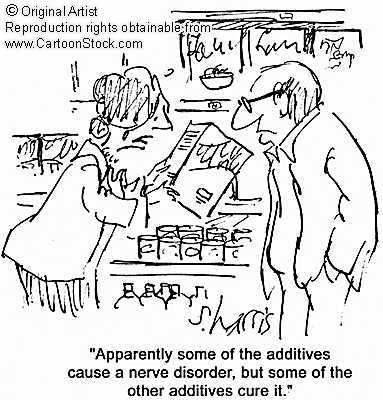|
12 Dangerous
|
Explanation of Additives
The food colorings that make candy pretty colors have been linked to cancer and tumors of the brain, thyroid, adrenal gland and kidney in animal studies. Explanation of additives on what colors your children should stay away from is below.
With any processed food you run the risk of coming across additives, and reading through ingredient labels can be like trying to decode a puzzle.
Look for them on ingredient labels and please by pass these products that are made with these ingredients.
Propyl Gallate (also any word with “Propyl”)
This preservative, used to prevent fats and oils from spoiling, might cause cancer. It's used in vegetable oil, meat products, potato sticks, chicken soup base and chewing gum, and is often used with BHA and BHT (see below).
BHA and BHT
Butylated hydroxyanisole (BHA) and butylated hydroxytoluene (BHT) are used similarly to propyl gallate -- to keep fats and oils from going rancid. Used commonly in cereals, chewing gum, vegetable oil and potato chips (and also in some food packaging to preserve freshness), these additives have been found by some studies to cause cancer in rats. If a brand you commonly buy uses these additives, look for a different variety, as not all manufacturers use these preservatives.
Potassium Bromate
This additive is used in breads and rolls to increase the volume and produce a fine crumb structure. Although most bromate breaks down into bromide, which is harmless, the bromate that does remain causes cancer in animals. Bromate has been banned throughout the world, except for in the United States and Japan. In California, a cancer warning would likely be required if it were used, which is why it is rarely used in that state.
Monosodium Glutamate (MSG)
MSG is used as a flavor enhancer in many packaged foods, including soups, salad dressings, sausages, hot dogs, canned tuna, potato chips and many more. Many consumers have also personally experienced the ill effects of MSG, which leave them with a headache, nausea or vomiting after eating MSG-containing foods. This is a great explanation of additives.
Aspartame (Equal, NutraSweet)
Like diet soda? Well, you won't like what you read. The aspartame that's used to sweeten it increases lymphomas, leukemia and brain tumors in rats -- even in small doses.
This artificial sweetener is found in Equal and NutraSweet, along with products that contain them (diet sodas and other low-cal and diet foods). This sweetener has been found to cause brain tumors in rats as far back as the 1970s, however a more recent study in 2005 found that even small doses increase the incidence of lymphomas and leukemia in rats, along with brain tumors. Read more on artificial sweetener.
People who are sensitive to aspartame may also suffer from headaches, dizziness and hallucinations after consuming it.
Editor’s note: We had a family friend, who used to drink diet coke for 30 years, his funeral was just a few years ago – he died of brain tumors, only 45 yrs. old. We all believe it was the artificial sweetener in these sodas he drank. Please tell your family about the "Explanation of Additives".
Acesulfame-K
Acesulfame-K is an artificial sweetener that's about 200 times sweeter than sugar. It's used in baked goods, chewing gum, gelatin desserts and soft drinks. Two rat studies have found that this substance may cause cancer, and other studies to reliably prove this additive's safety have not been conducted. Acesulfame-K also breaks down into acetoacetamide, which has been found to affect the thyroid in rats, rabbits and dogs.
Olestra
Olestra is a fat substitute used in crackers and potato chips, marketed under the brand name Olean. This synthetic fat is not absorbed by the body (instead it goes right through it), so it can cause diarrhea, loose stools, abdominal cramps and flatulence, along with other effects. Further, olestra reduces the body's ability to absorb beneficial fat-soluble nutrients, including lycopene, lutein and beta-carotene.
Sodium Nitrite (Sodium Nitrate)
Sodium nitrite (or sodium nitrate) is used as a preservative, coloring and flavoring in bacon, ham, hot dogs, luncheon meats, corned beef, smoked fish and other processed meats. These additives can lead to the formation of cancer-causing chemicals called nitrosamines.
Some studies have found a link between consuming cured meats and nitrite and cancer in humans.
Hydrogenated Vegetable Oil
The process used to make hydrogenated vegetable oil (or partially hydrogenated vegetable oil) creates trans fats, which promote heart disease and diabetes. The Institute of Medicine has advised that consumers should eat as little trans fat as possible. You should avoid anything with these ingredients on the label, which includes some margarine, vegetable shortening, crackers, cookies, baked goods, salad dressings, bread and more. It's used because it reduces cost and increases the shelf life and flavor stability of foods. See my article onFlaxseed Oil.
Artificial Coloring
Blue 1 and Blue 2
Blue 1, used to color candy, beverages and baked goods, may cause cancer. Blue 2, found in pet food, candy and beverages, has caused brain tumors in mice.
Red 3
This food coloring is used in cherries (in fruit cocktails), baked goods and candy. It causes thyroid tumors in rats, and may cause them in humans as well.
Yellow 6
As the third most often used food coloring, yellow 6 is found in many products, including backed goods, candy, gelatin and sausages. It has been found to cause adrenal gland and kidney tumors, and contains small amounts of many carcinogens.
"Explanation of Additives" is probably the most important page you read.
For more about explanation of additives go see "Food Additives"
Learn more about Splenda
Learn about Nutrasweet and Equal (Aspartame)
Learn more about Sweet n Low (pink packet)
Return from Explanation of Additives to Organic Homepage




